Lead-Safe Renovations for DIYers
 Available in these languages:
Available in these languages:
Arabic- عربى | Simplified Chinese-中文: 简体版 | Traditional Chinese-中文: 繁體版 | Dari-دری | French-Français | Korean-한국어 | Pashto-پښتو | Portuguese-Português | Russian-Pусский | Spanish-Español | Tagalog-Tagalog | Vietnamese- Tiếng Việt

Any renovation, repair, or painting (RRP) project in a pre-1978 home that has lead-based paint can easily create dangerous lead dust. If you are planning an RRP project in a pre-1978 home, EPA recommends homeowners hire a lead-safe certified contractor who is certified and trained in lead-safe work practices, meaning a group of techniques to prevent lead exposure resulting from renovation and repair activities. And in fact, the RRP rule requires that contractors performing RRP projects in pre-1978 homes, child care facilities, and preschools be lead-safe certified.
Generally speaking, the RRP rule does not apply to homeowners doing RRP projects in their own home. However, it does apply if you rent all or part of your home, operate a child care center in your home or if you buy, renovate and sell homes for profit (i.e., a house flipper). If you decide to do the work yourself, make sure to use lead-safe work practices for do-it-yourself (DIY) home renovation projects to protect you and your family.
You can prevent dangerous lead dust from spreading throughout your home with the following DIY lead-safe work practices:
- Determine if lead-based paint is present;
- Set up safely;
- Protect yourself;
- Minimize dust;
- Leave your work area clean;
- Control your waste; and
- Clean one more time.
These practices take a small amount of time and money, but are necessary to protect family members, especially children, from exposure to lead dust.
When used correctly, these practices prevent lead exposure both during and after a home renovation.
Determine if Lead-based Paint is Present
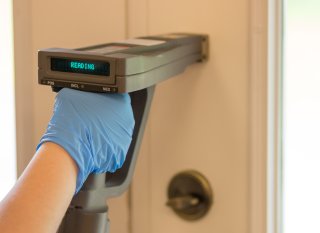
Before starting an RRP project in your home, you should find out the year it was built to know whether lead-based paint may be an issue. If your home was built before 1978, it may have lead-based paint; the older your home, the more likely it has lead-based paint. EPA recommends hiring a certified lead inspector or lead risk assessor to test your home and determine if the surfaces you are renovating have lead-based paint.
If you are unable to determine the age of your home, it’s safest to assume the area you are renovating has lead-based paint and use the DIY lead-safe work practices described below.
Set up Safely

When doing a DIY job that involves lead-based paint, you should contain your work area to prevent dust and debris from escaping into the rest of your home. The goal of your work area setup is to keep dust in your work area and keep family members and anyone not working on your DIY project out. This can be accomplished by posting warning signs and by establishing barriers around your work area.
To set up safely, make sure to:
- Remove all furniture, area rugs, curtains, food, clothing, and other household items from your work area until cleanup is complete.
- Tightly wrap with plastic sheeting and seal with tape items that cannot be removed from your work area.
- Cover floors with plastic sheeting.
- Close and seal all doors in your work area.
- If needed, construct an airlock at the entry to your work area.
- An airlock consists of two sheets of thick plastic. One sheet is completely taped along all four edges. The plastic sheet is then cut down the middle. The second sheet is only taped along the top and acts as a flap covering the slit in the first sheet of plastic.
- Turn off forced-air heating and air conditioning systems. Then cover vents with plastic sheeting and tape the sheeting in place.
- Close all windows in your work area.
Protect Yourself
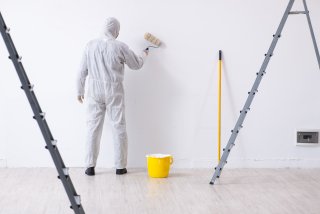
Without the correct personal protective equipment, you may ingest or inhale lead dust from your DIY home renovation project and could risk bringing lead from your work area into the rest of your home. To protect yourself and your family, consider wearing:
- A disposable N-100 certified respirator;
- Disposable coveralls to limit contamination of your clothing;
- A painters’ hat to protect your head from dust and debris;
- Disposable shoe covers to prevent the tracking of dust from your work area and protect your shoes from exposure to dust; and
- Eye protection and gloves.
You should wash your hands and face every time you stop working and wash your work clothes separately from the rest of your family’s laundry. Do not eat, drink, or smoke in your work area since dust and debris can contaminate food and other items and cause you to ingest hazardous lead dust.
Minimize Dust
As you scrape, drill, cut, open walls, remove trim, demolish, or perform other renovation activities, you create dust that may contain lead. By using the right tools and following simple practices, you can minimize and control the dust while you work. Make sure to keep your work area closed off from the rest of your home.
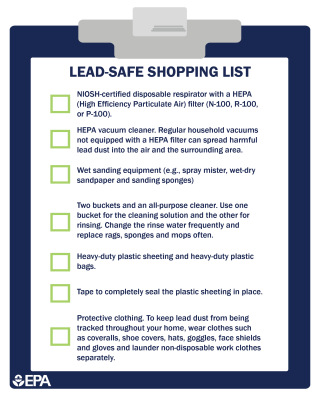
The following items can help you minimize dust and are available through hardware, paint, garden supply stores, or other specialty suppliers:
- Wet-dry sandpaper and/or a sanding sponge;
- Spray mister or pump sprayer to mist areas before sanding, scraping, drilling, and cutting to keep the dust down;
- Heavy plastic sheeting;
- Utility knife or scissors;
- Masking tape, duct tape, or painters’ tape;
- High Efficiency Particulate Air (HEPA) vacuum cleaner;
- Heavy duty plastic bags;
- Tack pads (large, sticky pads that help remove dust), paper towels, or disposable wipes;
- Low-temperature heat gun (under 1,100 degrees Fahrenheit) to remove paint or other surface coatings;
- Chemical strippers to help break down and release paint without scorching the surface or creating flying paint chips and dust, some chemical strippers contain
hazardous substances so you should always follow manufacturer’s instructions
regarding the safe use and handling of these products; and - Power tools with HEPA filter equipped vacuum attachments to contain the dust created by these tools.
Leave Your Work Area Clean
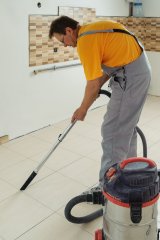
Your work area should be left clean at the end of every day. At the end of your DIY project, you should clean your work area until no dust, debris, or residue remains. Keeping your work area clean will help minimize dust and protect you and your family. Many of the supplies listed in the section above are not only helpful in minimizing dust, but can also be used when cleaning your work area. In addition to those materials, you should consider using other supplies to help clean, including:
- Heavy-duty plastic bags;
- Disposable wet-cleaning wipes or hand towels;
- All-purpose cleaners;
- Mop and disposable mop heads;
- Two buckets (or two-sided bucket with ringer);
- Shovel and rake;
- Wet mopping system; and
- Electrostatically charged dry cleaning cloths.
Keep your work area clean by putting trash in heavy-duty plastic bags as you work, vacuuming your work area with a HEPA vacuum cleaner frequently, cleaning your tools every day, washing your hands and face every time you take a break and at the end of the day, disposing of or cleaning your personal protective equipment, and keeping non-workers out of your work area.
Control Your Waste

Waste from your DIY home renovation projects should be collected and controlled to prevent the release of dust and debris before it is removed for disposal. This includes dust, debris, paint chips, protective sheeting, HEPA filters, dirty water, cloths, mop heads, wipes, protective clothing, respirators, gloves, architectural components, and other waste. Use heavy plastic sheeting or bags to collect your waste and seal everything securely with duct tape and even consider double bagging the waste to prevent tears.
Because EPA considers most residential renovation and remodeling to be “routine residential maintenance,” most waste generated during these activities is classified as solid, non-hazardous waste, and should be taken to a licensed solid waste landfill.
However, always check local and state waste disposal requirements before disposing
of renovation waste.
Clean One More Time
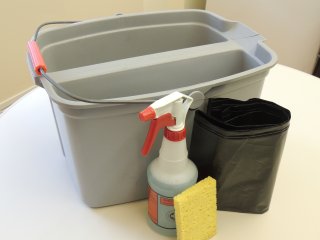
After completing your DIY home renovation project, and before letting family members back in your work area you should do the following:
- Mop uncarpeted floors thoroughly;
- Clean walls with a HEPA vacuum or a damp cloth;
- Thoroughly vacuum all remaining surfaces and objects, including furniture and fixtures, with a HEPA vacuum; and
- Then wipe down all surfaces with wet disposable cleaning cloths until the cloths are clean.
You can also hire a certified lead dust sampling technician, lead-based paint inspector, or lead-based paint risk assessor to perform clearance testing to confirm your work area is clean.
For more detailed information on how to renovate safely in your pre-1978 home, review Steps to LEAD Safe Renovation, Repair and Painting (PDF).
As a reminder, DIY projects can easily create dangerous lead dust, so EPA recommends homeowners hire lead-safe certified contractors for all RRP projects in pre-1978 homes. If you decide to hire a contractor to work on your pre-1978 home, the RRP rule requires them to be lead-safe certified. Make sure to ask contractors if they are lead-safe certified or use EPA’s search tool to find lead-safe certified contractors in your area.
